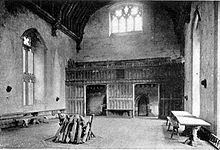William de Ramsey
(Redirected from
William Ramsey (architect)
)

William de Ramsey (
Perpendicular style of Gothic architecture.[1] William Ramsey was likely an inventor of the Perpendicular style which was to dominate Gothic architecture in England for three centuries "and, if so, he was one of the most influential architects England has ever produced".[1]
The son of
presbytery of Lichfield Cathedral and was charged with supervising building at Stephen's Chapel the same year.[1] The chapter house at St Paul's and St Stephen's in Westminster are known from existing fragments and contemporary illustrations to have been in Perpendicular style, the first buildings to have been built this way.[1]
In 1335 he was one of four commissioners responsible for a report on the
Chief Surveyor of the King's Works there and for all castles south of the River Trent, a lifetime appointment.[1][3] The great hall and other parts of Penshurst Place (1341–48) were likely his work.[1]

William de Ramsey was a scion of the de Ramsey family of master masons whose work, according to
John Harvey, can be found at Ramsey Abbey, Norwich Cathedral, Ely Cathedral, and possibly also in Paris.[4][page needed] Ramsey died of plague in 1349, during the Black Death. William Ramsey's daughter, Agnes Ramsey, carried on his workshop after his death.[5]
References
- ^ ISBN 978-0-19-967498-5, retrieved 17 May 2020
- ISBN 978-0-19-967498-5, retrieved 17 May 2020
- ISBN 0195395360. Retrieved 2 February 2019.
- B.T. Batsford.
- ISBN 1852853468.
Bibliography
- "William de Ramsey". encyclopedia.com. Retrieved 29 October 2009.
- Harvey, John (1946). Henry Yevele: The Life of an English Architect. London: B.T. Batsford.
